Ricoh GXR: Custom Settings
Motivation: Why I Finally Decided to Dig into this Matter... | Introduction: How the Custom Settings Are Organized | Creating, Refining, and Using the Settings Sets | Switch Shooting Mode | How to Use the Custom Settings | Conclusions | Links | Appendix: The Settings Screens
Archive
On this page, I describe how you can record up to twelve sets of custom settings for the Ricoh GXR, six so-called box modes, and six sets of settings that are stored on the memory card (introduced with the introduction of the M-mount expansion unit).
Note: Here you can find an application of custom settings where my focus is on recording lens information for the M-mount expansion unit in the Exif data.
Motivation: Why I Finally Decided to Dig into this Matter...
I used the Ricoh GXR for years without dealing much with the custom settings. I was simply too lazy to take a closer look at them, because I thought that I did not need them - and the description in the manual looked daunting to me. And even if I create some custom settings, after a while I have forgotten what they are good for (it's the same with my wife and her compact Ricohs...).
Recently, however, with a growing collection of M-mount lenses, the wish and need came up to store which lens was used in the Exif data of a photo. Particularly, when I performed tests with several lenses, I was usually unable afterwards to uncover, which lens was used for which photo, making the whole test useless. Since the M-mount expansion unit is completely agnostic of the used lens and settings (aperture, distance), you have to tell the camera what lens and settings you are using to record it for you, for example, in the Exif data. Otherwise you need to write that down with paper and pencil, which is unthinkable for me...
So I finally decided to dig into the dry and complex matter of custom settings and find out what they can do for me. You can find how I use the custom settings for recording the lens (that is the lens name, and maybe its focal length and actual or maximum aperture) elsewhere. On this page, I present the custom settings under a general viewpoint, however, without discussing how the settings might be used. Thus, here I will explain only the "mechanics" of using custom settings.
In the following, I will describe how the custom settings are organized on the Ricoh GXR and how you can create sets of them, store them, and recall them for use.
Introduction: How the Custom Settings Are Organized
The Ricoh GXR has three primary sets of custom settings MY1, MY2, and MY3 (I will call them collectively "MYx"), which can be easily accessed from the mode dial. They can also be given names that indicate their purpose (provided you choose a proper name...). So, at least on the GXR, there is no excuse for not remembering what a set of settings is good for. However, you have to activate that names are displayed in the menu - otherwise, you will only see the generic "MYx" names.
In addition to the three "MYx" sets of custom settings, the Ricoh GXR offers six more stores for sets of custom settings in the "My Settings Box" (also called "box modes"). Since the introduction of the M-mount expansion unit (as far as I know...), it offers six more stores for sets of custom settings on the camera's memory card (called "Card"), resulting all in all in twelve storage locations for sets of custom settings.
The twelve additional storage locations are, however, not directly accessible - only the three "MYx" setting sets on the mode dial are. Being only able to access three sets of settings directly, makes things a little complicated: If you need to use another set, you have to copy it to one of the three "MYx" locations and thus, overwrite a set (which should be stored safely in one of the twelve storage locations).
Creating, Refining, and Using the Settings Sets
A set of custom settings comprises a huge number of options, which can all be set in a dedicated menu. I would like to refer you to the GXR manual and to the manuals of the individual camera units (because these may differ in the possible options) for details. See also Appendix: The Settings Screens for the settings screens for the M-mount expansion unit as an example.
In the following, I describe how you can create sets of settings, assign them to one of the 15 possible storage locations, edit them, and copy them to the three "MYx" storage locations for direct access from the mode dial.
All "settings work" is done in the "Key Custom Options" tab in the menu, where you have three options (starting from the top of the menu page) to deal with sets of settings:
- Reg. My Settings (Register My Settings): Allows you to store the current settings in any storage location, either MY1 to MY3 (three locations), the "My Settings Box" (six locations), or on the "Card" (memory card, six locations).
- Recall My Settings: Allows you to select a set of settings from one of the twelve storage locations (six from the "My Setting Box", six from "Card") and assign it to one of the three "MYx" locations (MY1, MY2, or MY3). Actually, it's the other way round: first you select the target location, then the set of settings.
- Edit My Settings: Allows you to edit a set of settings in any of the 15 locations, either in MY1 to MY3 (three locations), the "My Settings Box" (six locations), or in "Card" (six locations). If you select a set in "Card" and there is none, you are returned to the menu. Thus, you have to save a set on the memory card before you can edit it.
In the following, I describe the three functions in more detail.
Register My Settings
Start from a state of camera settings that are useful for a certain purpose and then register these in a set of custom settings using the menu. To do so, press the "MENU/OK" button and select the "Key Custom Options" tab (the second tab).
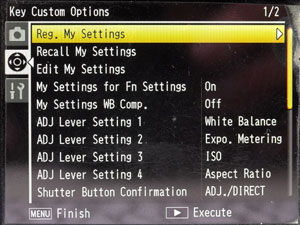 |
In the "Key Custom Options", select "Reg. My Settings" and move the cursor to the right. You can store the current settings in any storage location, either MY1 to MY3 (three locations), the "My Settings Box" (six locations), or on the "Card" (memory card, six locations). |
|
I only show the two two latter cases: |
||
| My Settings Box: | Card: | |
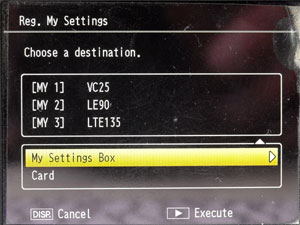 |
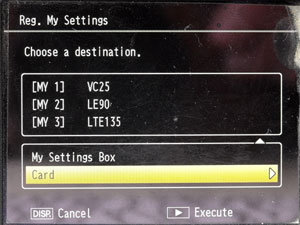 |
|
| Select "My Settings Box" and move the cursor to the right. | Select "Card" and move the cursor to the right. | |
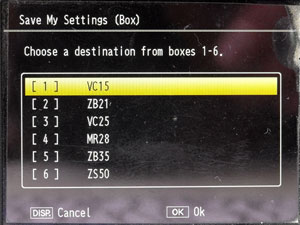 |
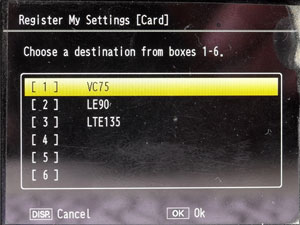 |
|
Select one of the six locations and press "OK" (you can replace or update an existing setting). |
Select one of the six locations and press "OK" (you can replace or update an existing setting). | |
Overwriting Existing Settings, Confirmation, Naming
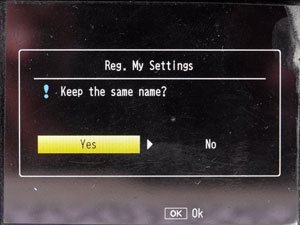 |
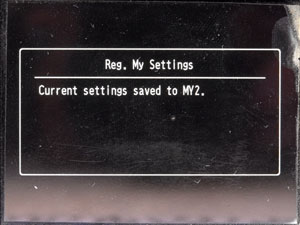 |
|
| If there is already data in a storage location, a dialog appears that asks you whether you want to keep the current name of the settings (for the M-mount expansion unit, the dialog is a little different). | Finally, you get a confirmation message that the settings are registered in the selected location. In this case, it is an "MYx" location, namely MY2. |
The settings will automatically be given a name that reflects the date of the registering. Here you can see these "automatic names" for the three "MYx" location:
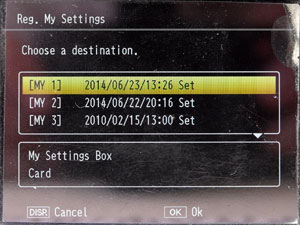
You may change the name later by editing the set (see below).
Edit My Settings
This functionality allows you to edit and thus, refine, a set of settings after you saved it in one of the 15 storage locations. Usually, you will find that some changes to the initial settings are required, and this is the way to go if you want/need to refine your settings. To do so, press the "MENU/OK" button and select the "Key Custom Options" tab (the second tab).
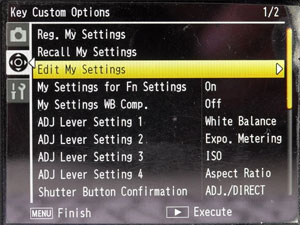 |
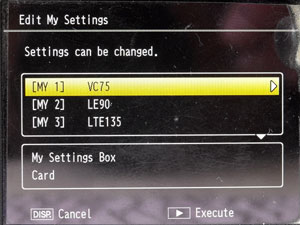 |
|
| In the "Key Custom Options", select "Edit My Settings" and
move the cursor to the right.
|
You can edit the settings in any storage location, either MY1 to MY3 (three locations), the "My Settings Box" (six locations), or on the "Card" (memory card, six locations). | |
I show only the case than an "MYx" location is selected. Select "MYx" and move the cursor to the right to arrive at the first of several screens for setting options: |
||
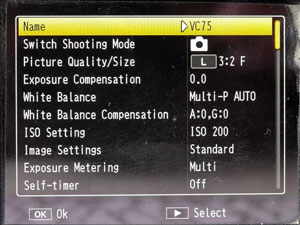 |
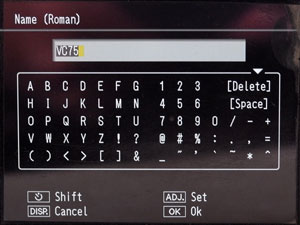 |
|
| You start with the first of five settings screens. The first item on this screen allows you to give a set of settings a descriptive name (here it is a short name for a lens) | Move the cursor to the right to enter the settings name using a small alphanumeric keyboard. | |
A set of settings comprises a huge number of options, which can all be set in the settings screens. I would like to refer you to the GXR manual and to the manuals of the individual camera units (because these may differ in the options they offer) for details. See also Appendix: The Settings Screens for the M-mount expansion unit's settings screens as an example.
Display of Custom Settings Name
In the "Setup" menu, you can activate that the name of the customs settings sets are displayed:
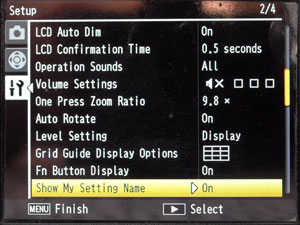 |
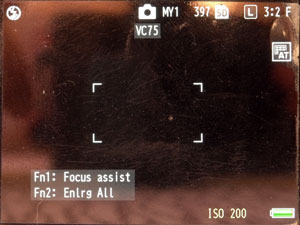 |
|
| Option "Show My Setting Name" in the "Setup" menu activate the display of the settings names (see photo to the right) | Settings name, here "VC75", displayed (only for a few seconds, though...) |
Note that the settings name is displayed only for a few seconds after you turn the camera on or turn the mode dial to the respective "MYx" setting.
Recall My Settings
If you stored more than three sets of settings, that is, more than can be directly accessed from the mode dial, you will from time to time need to recall a set, assign it to one of the three "MYx" storage locations, and then turn the mode dial to this "MYx" option to activate the settings.
To assign a set of settings to an "MYx" location, first press the "MENU/OK" button and select the "Key Custom Options" tab (the second tab).
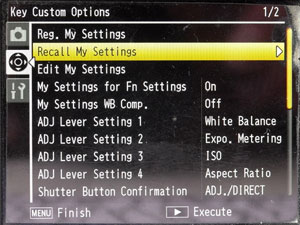 |
In the "Key Custom Options", select "Recall My Settings" and move the cursor to the right.
|
|
| You can recall the settings from the "My Settings Box" (six locations) or the "Card" (memory card, six locations) and store them in one of the three "MYx" locations. | ||
| My Settings Box: | Card: | |
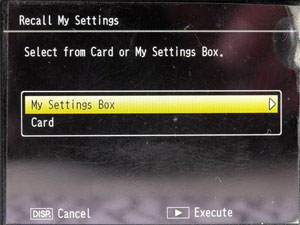 |
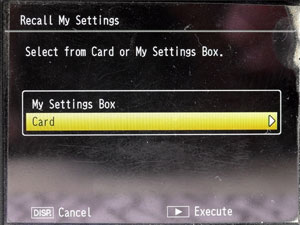 |
|
| First, select "My Settings Box" and move the cursor to the right. | First, select "Card" and move the cursor to the right. | |
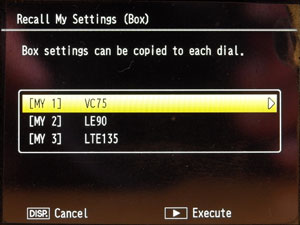 |
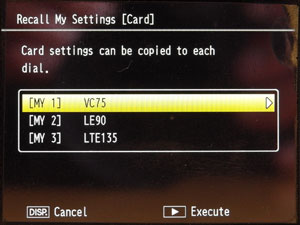 |
|
| Next, select the desired "MYx" setting (in this case, it is MY1) and move the cursor to the right again. | Next, select the desired "MYx" setting (in this case, it is MY1) and move the cursor to the right again. | |
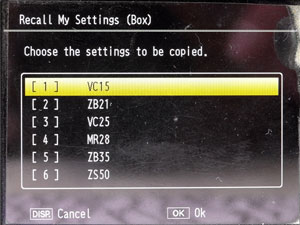 |
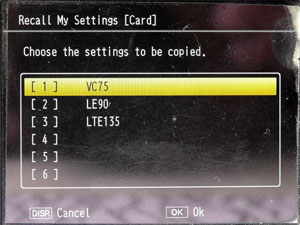 |
|
| Then, select one of the six box locations and press "OK". | Then, select one of the available card locations and press "OK". | |
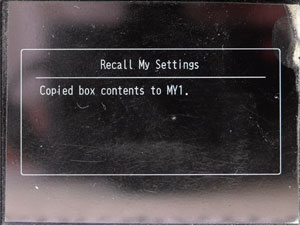 |
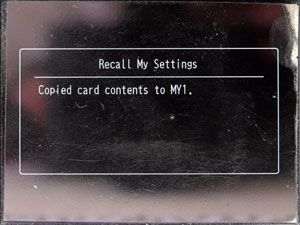 |
|
| Finally, you will get a confirmation message that the settings will be recalled from the selected location and copied to the selected "MYx" location (in this case, it is MY1). | ||
There may be many strategies for assigning sets of settings to the 15 locations. Since this is quite a complex matter, I will not discuss this topic here.
To activate the settings in a "MYx" storage location, turn the mode dial to the respective "MYx" position.
Card Settings - Caveats
Usually, I format a card after it is full. This prevents, among others, that directory errors will accumulate and is also much faster than deleting individual images. If, however, sets of settings are stored on a memory card, these are lost after formatting the card. I therefore store the "Card" settings sets (located in folder MYSET on the card) on my computer and copy them back to the card after it was formatted.
Please note that different camera units may use different sets of settings. However, the settings that are stored on a memory card are used by all the units - which may not make much sense. Perhaps it is therefore advisable to use card settings only with the M-mount expansion unit and reserve a memory card of its own for it - I do not think that the other camera units need more than six sets of settings.
What the Exif Data Shows
As far as I know, only lens information is added to the Exif data when you use custom settings - and this is only the case for the M-mount expansion unit. For this unit, the lens (short) name is added to the already existing camera name (for example, GXR MOUNT A12_LE90). If you set the focal length and the f-stop, these appear also in the respective Exif fields, otherwise these fields remain empty. For other camera units, however, these two fields are filled with the respective values that were used by the camera, but this has nothing to do with custom settings.
Switch Shooting Mode
Ricoh introduced the function "Switch Shooting Mode" to support mode handling for the custom settings. It took me a while to understand that this function actually serves two purposes:
- To temporarily switch the shooting mode when one of the three MYx settings
is set on the mode dial.
This setting gets lost when the mode is changed or the camera is turned off. - To change = edit the shooting mode for an already defined MYx set of custom
settings in the menu.
This setting remains in effect until you edit the set again.
1. Switch Shooting Mode when in MYx Mode (Mode Dial)
When you select a MYx mode on the mode dial, the camera sets the shooting mode (Auto, P, A, S, M, or SCENE mode) that was assigned to this MYx mode. You can change the shooting mode temporarily, that is, until you change the MYx mode to another MYx or shooting mode or if you switch the camera off. This is done in the "Shooting" menu using item "Switch Shooting Mode" (see Figures below).
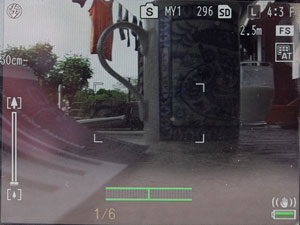 |
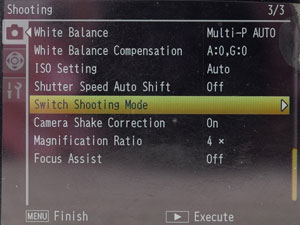 |
|
| MY1 is selected, the camera is in S mode
|
In the "Shooting" menu, "Switch Shooting Mode" is selected | |
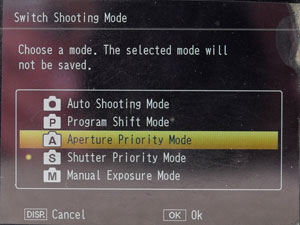 |
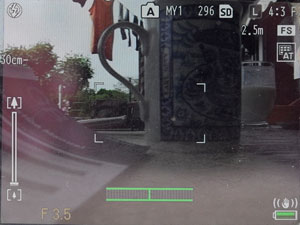 |
|
On the "Switch Shooting Mode" screen, A mode is selected ... |
... and appears on the shooting screen |
2. Change Shooting Mode for a MYx Set of Custom Settings
When you created a MYx set of custom settings and want to change the shooting mode (or you forget to set it properly at the beginning), you can do so by using the "Switch Shooting Mode" function as well, but this time by entering the "Key Custom Options" menu, selecting item "Edit My Settings", then selecting the respective MYx mode and finally item "Switch Shooting Mode" (see Figures below). Depending on the Shooting mode, you can also save and aperture (A mode), shutter speed (S mode) setting or both (M mode) (see Figures below).
The Figures below show how you can select a shooting mode and set aperture, shutter speed, or both while editing a MYx set of custom settings.
| Auto Mode | P (Program) Mode | |
 |
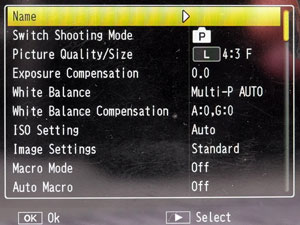 |
|
| Auto mode (aperture and shutter speed not set) | P mode (aperture and shutter speed not set) | |
| A (Aperture Priority) Mode | ||
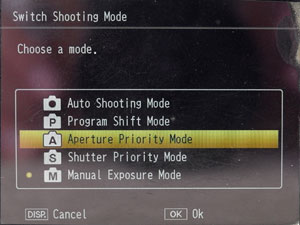 |
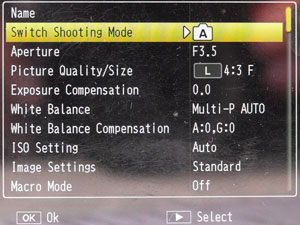 |
|
| Selecting A mode on the "Switch Shooting Mode" screen, M mode was selected | A mode selected | |
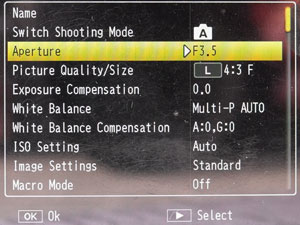 |
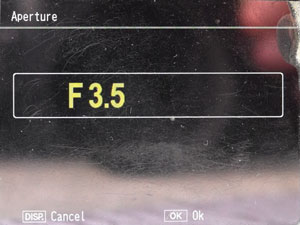 |
|
| Setting the aperture value (lists a value if one had already been selected) | Screen for setting the aperture value | |
| S (Shutter Priority) Mode | ||
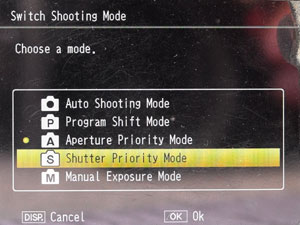 |
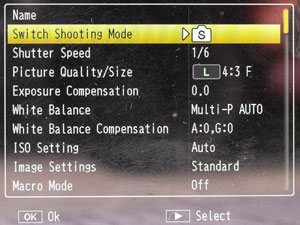 |
|
| Selecting S mode on the "Switch Shooting Mode" screen, A mode was selected | S mode selected | |
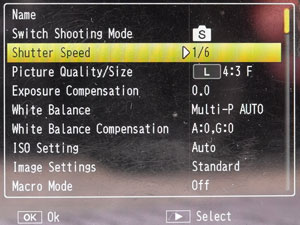 |
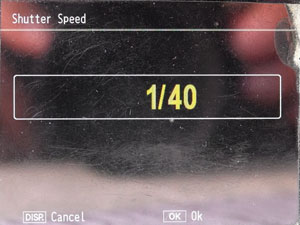 |
|
| Setting the shutter speed (lists a value if one had already been selected) | Screen for setting the shutter speed | |
| M (Manual) Mode | ||
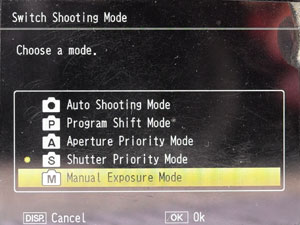 |
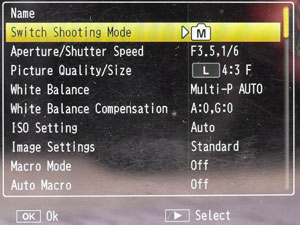 |
|
| Selecting M mode on the "Switch Shooting Mode" screen, S mode was selected | M mode selected | |
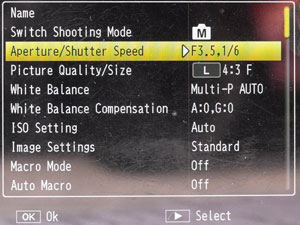 |
||
| Setting the shutter speed (lists values if these had already been selected) | ||
 |
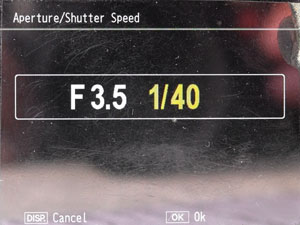 |
|
| Screen for setting aperure value and shutter speed, aperture value selected | Screen for setting aperure value and shutter speed, shutter speed selected |
How to Use the Custom Settings
On this page, I more or less describe the "mechanics" of the custom settings for the Ricoh GXR. Since I did not use them up to now, I cannot give any useful advice on this matter. I therefore would like to point you to some place on the Web where this topic is dealt with.
Note: Further information on custom settings should be found in the Ricohforum and in the Ricoh forum at dpreview.com.
Tom Caldwell's Modes Matrix for the GXR (Excel Spreadsheet)
First of all and most notably, Tom Caldwell published an Excel spreadsheet with box settings for the Ricoh GXR with P10 camera unit, but this should be easily adapted to other modules. Note that Caldwell published the spreadsheet before the ability to store sets of custom settings on a memory card was available (six more locations in addition the the six box location that are stored within the camera unit). Also note that the spreadsheet is "work in progress" that seems to have never been finished (it included "undecided" and "experimental" options... ) - see Tom's remarks from 2015 on page Ricoh GR: Custom Settings.
You can find the spreadsheet (RicohGXR.xls) and the related discussion thread "Ricoh GXR Specimen Setup Matrix" on the Ricohforum.
Tom Caldwell also published GR and GRD III versions of the mode matrix of custom settings. See page Ricoh GR: Custom Settings for details and links.
Tom Caldwell's Comments on Custom Settings in 2015
In 2015, a new discussion about GXR custom settings arose in the Ricoh forum on dpreview.com. See the respective thread "GXR box settings (for Jim)" for details. In this thread, Tom Caldwell made two longer replies to my postings and explained how he uses the GXR custom settings. He allowed me to cite and adapt his postings for your information. Here is the technique that he has developed and proposed in the thread:
Use of Custom SettingsI have settled on three basic My modes which I have labeled self-descriptively "Good Light", "Quick" (low light / higher ISO) and "Black & White". I store second copies of these in box modes to allow me to play with and adjust the other three in actual use. The other three box modes I use for more "odd" uses such as square format or to switch focus peaking modes. I have not used card storage. A Proposal for Playing Around with Custom SettingsI also note a much easier way to create My/box mode outlines - just use the camera normally - adjusting to your personal taste/requirements then save the current camera state as a copy to a My mode and a box mode. Remember to name each setting saved. Now you can play with your saved My mode and if you improve it then you can update the saved settings. If you like the original you can restore it from the box mode to the My mode. (Original posting: www.dpreview.com/forums/post/55728814) Using My Modes in A "Layered" FashionThe best thing about using modes is that because they are so powerful you can make them into many things. Simply put: I use my modes as several layers of settings. 1) The deepest layer is the box mode, which is the "fall back" to settings that I prefer to use which suit me as:
These are all aperture priority, but there is also a shutter priority in the box modes where good shutter speed is essential for moving objects. Of course I can change any of my aperture priority modes to shutter priority or manual with a short trip into the menu system. 2) The three My modes - always a sub-set taken from my six box modes. These are my regular "start up sets." But often when out and about photographing I find, for example, that the default aperture that I am using doesn't suit the situation and that the shots I am taking are far enough apart to warrant switching the camera off and on. To save adjusting the aperture every time I switch on, I simply save the currently desired aperture and EV to the My mode. In the case of the APS-C zoom, this includes the zoom position of the lens which then can start up zoomed out if you so desire. 3) At the end of the day, I can chose to set my My mode back to the original if the changes were few or to recall the associated box mode and re-save it to the My mode and know that it is back to my known defaults without further need to check or remember. Another possibility is that I might be so overcome by my new grasp of settings that might chose to retain the adjusted My mode and save it also to the associated backup in the box mode. Conclusion: In this context, box mode might be thought of as "backup mode" and "My mode" as "camera switch-on mode". (Original posting: www.dpreview.com/forums/post/55735105) |
Card Settings
The settings that are stored on a memory card are used by all the GXR camera units. I therefore suggest to use card settings only with the M-mount expansion unit and reserve a memory card of its own for it - I do not think that the other camera units need more than six sets of settings. Also save the card settings on your local computer so that you do not loose the settings by accident, for example, by formatting the memory card.
For details on using card settings for the M-mount expansion unit see page Recording the Lens in Exif.
Conclusions
I am just at the beginning of using the custom settings myself. Experience will show, whether I will really use this feature. It took me indeed a while to scan the manuals and search the Internet before I understood how it works. Once understood, it is, however, fairly simple.
Links
- Ricoh forum in dpreview.com: forums.dpreview.com/forums/forum.asp?forum=1013
- GXR box settings (for Jim) (thread started by A Subset): www.dpreview.com/forums/post/55723823
- Thanks, and more information (posting by Tom Caldwell ): www.dpreview.com/forums/post/55728814
- "B" is for Backup? (posting by Tom Caldwell): www.dpreview.com/forums/post/55735105
- GXR - can you freeze a modified MY setting? (thread started by A Subset): www.dpreview.com/forums/post/55717233
- Ricohforum (Pavel Kudrys): ricohforum.com
- Ricoh GXR Specimen Setup Matrix (posting by Tom Caldwell): www.ricohforum.com/viewtopic.php?f=60&t=5196&start=0&hilit=GXR+matrix&sid=e598b843375f37006889e1e159836a35
- GXR mode matrix spreadsheet (RicohGXR.xls) (Tom Caldwell)
Appendix: The Settings Screens
In addition to the settings that are a subset of the menus and that are listed on the settings screens when you edit the custom settings, the following camera settings are also registered in the MYx settings (for details see p. 129 in the GXR manual):
- Shooting mode: Auto, P, A, S, M, SCENE, Video? (for details see above)
- Aperture value and shutter speed when A/S/M mode (A: aperture, S: shutter speed, M: both) (for details see above)
- Self-timer
- Focus position for MF
- Macro
- Flash
Below are the custom settings screens for the M-mount expansion unit (in Auto shooting mode, therefore neither aperture nor shutter speed can be edited). Other camera units may have slightly different settings screens depending on their technical characteristics.
 |
 |
|
| Settings screen 1 | Move the cursor to the right to enter the settings name using a small alphanumeric keyboard. | |
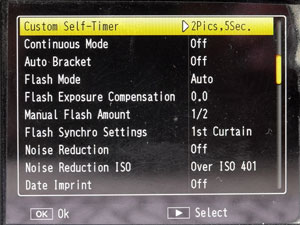 |
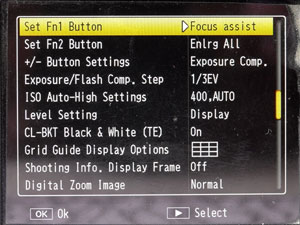 |
|
| Settings screen 2 | Settings screen 3 | |
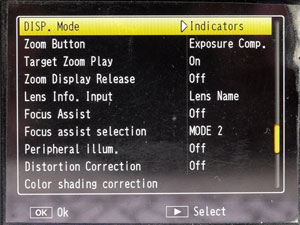 |
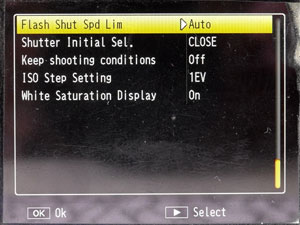 |
|
| Settings screen 4 | Settings screen 5 |
| 19.11.2020 |